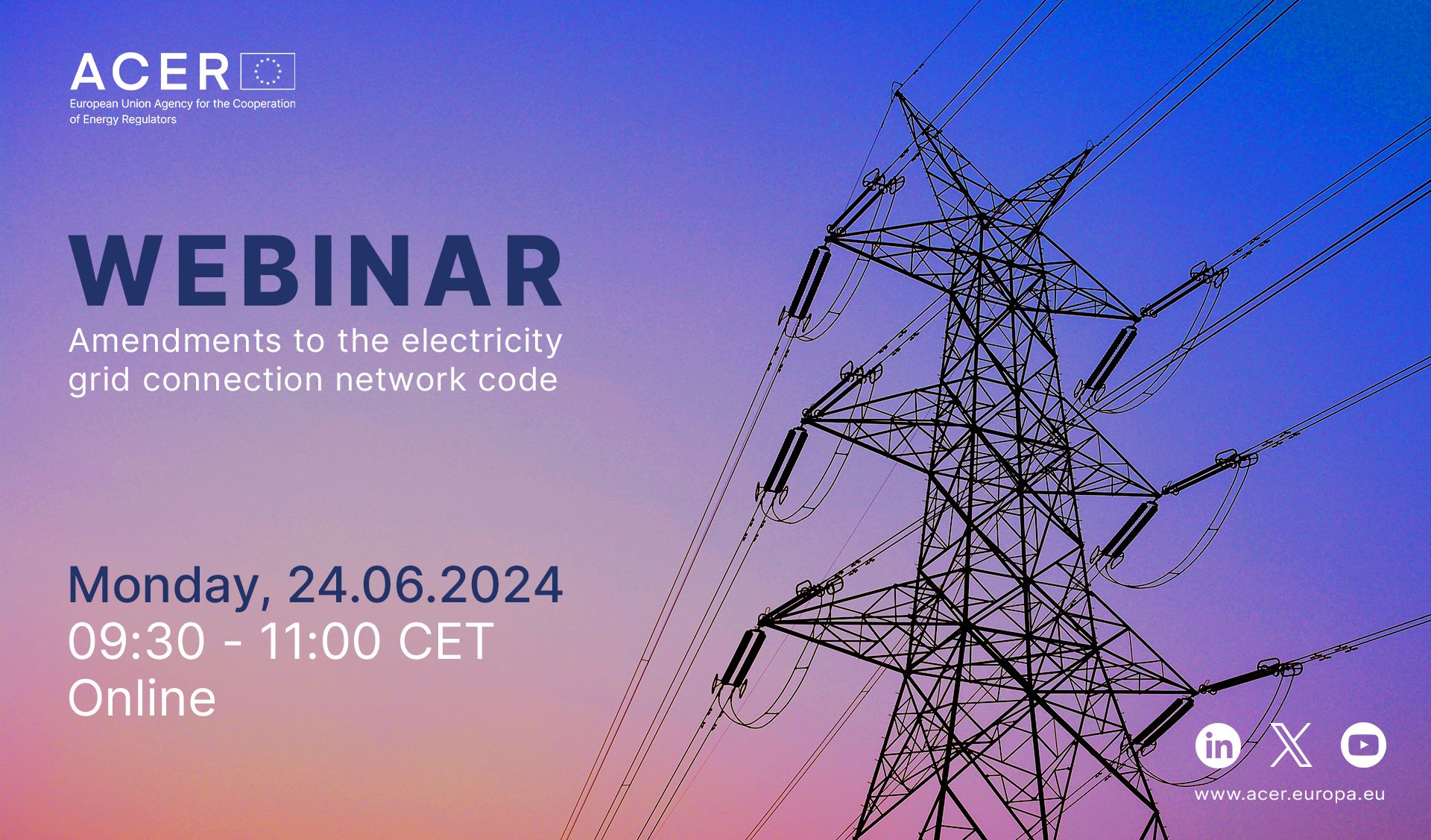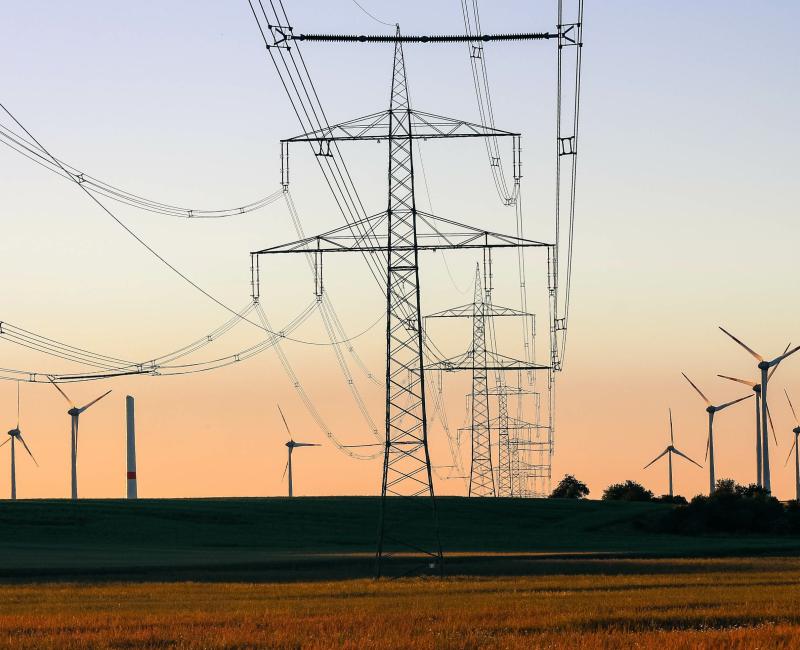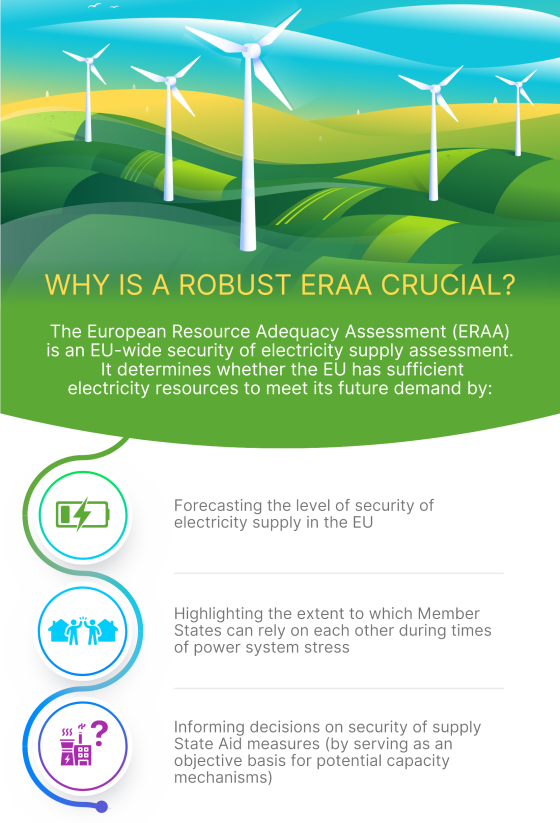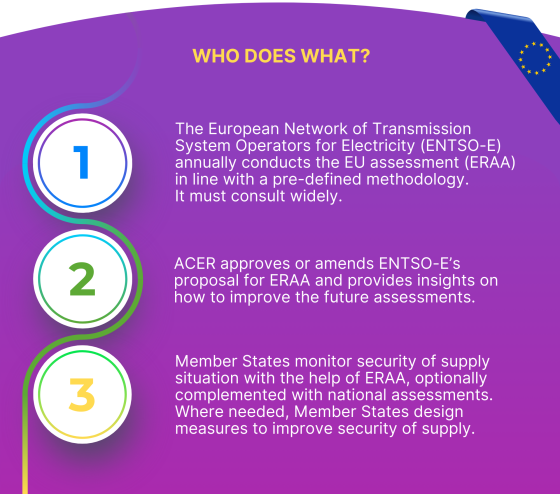ACER webinar: amendments to the electricity grid connection network code
ACER webinar: amendments to the electricity grid connection network code

Expert Group on Power Purchase Agreements (PPAs)
Expert Group on Power Purchase Agreements (PPAs)
Scope of the group

The main focus of the expert group is to advise on the need for voluntary templates for PPA contracts within the European energy market, exploring their feasibility, main benefits and drawbacks. Experts will help ACER assess whether these templates will foster the transparency, efficiency and integration of the European internal energy market, and build the necessary knowledge to ensure alignment with other European energy policies and objectives.
The expert group will operate from spring to summer 2024, with the possibility of extending into 2025 for further analysis on the development of such contracts.
The PPA expert group is composed of the following members:
- Mr Stefano Alaimo
- Mr Masoud Asgarpour
- Mr Juan Bajo Abad
- Mr Francis Browne
- Ms Margaux Delaune
- Mr Janos Hettyey
- Ms Inger Kristin Holm
- Ms Mariya Manolova
- Mr Joshua Roberts
- Ms Annie Scanlan
- Mr Colin Spain
- Mr Stefan Ulreich
- Mr Wouter Vandorpe
- Mr Mathieu Ville
Minutes
↓ See also
ACER’s updated methodology improves the operational security analysis in electricity systems

ACER’s updated methodology improves the operational security analysis in electricity systems
What is it about?
On 13 May 2024, with its Decision No 07/2024, ACER amended the methodology for Coordinating Operational Security Analysis (CSAM).
The amendment proposal was submitted to ACER in November 2023 by the European Network of Transmission System Operators for Electricity (ENTSO-E), on behalf of Transmission System Operators (TSOs).
What is the role of the methodology?
CSAM supports the EU’s operational security by outlining the TSOs' requirements to ensure:
- the electricity transmission system is operated in a coordinated manner;
- an effective system operational planning;
- transparency and reliability of information on transmission system operation.
The methodology was first approved by ACER in 2019 under the Guideline on Electricity Transmission System Operation (SOGL) and amended in 2021.
What are the main improvements in the methodology?
The amendments relate to the implementation of the observability area (i.e., where TSOs implement real-time monitoring and modelling of their systems to maintain operational security), following the recommendations of the Incident Classification Expert Panel’s final report on Continental Europe Synchronous Area Separation on 8 January 2021.
The main changes include:
- Aligning the observability area reassessment period with that of the external contingency list (i.e., the list of contingencies to be simulated to test the compliance with the operational security limits). This alignment is important to ensure that the operational security analysis is carried out accurately across all timeframes.
- The inclusion of busbar couplers in the contingency lists and in the TSOs’ Individual Grid Models (IGMs), along with a defined timeline for implementation by the TSOs. This update ensures that the power flows are kept within the operational security limits after a contingency has occurred.
What are the next steps?
Within a year after the adoption of the new CSAM (by 13 May 2025), TSOs are required to update their ordinary contingency lists. These updates must specifically include the loss of a single busbar coupler, whether protected by an overcurrent protection device or by an over-/under-voltage protection device.
ACER’s latest REMIT Quarterly is out

ACER’s latest REMIT Quarterly is out
What is it about?
REMIT (Regulation on Wholesale Energy Market Integrity and Transparency) provides an EU framework for the transparency and integrity of energy markets and aims to deter market participants from manipulating the market. It plays an important role in protecting the interests of companies and consumers and ensuring trust in energy markets.
To ensure the REMIT Regulation keeps pace with evolving market dynamics, the European Commission launched a legislative proposal for its amendment in March 2023. A year later, the European Parliament and the Council adopted the new REMIT Regulation.
What is the REMIT Quarterly?
The REMIT Quarterly is ACER’s main channel of communication with stakeholders on REMIT-related matters, providing updates on ACER’s REMIT activities.
The 36th edition covers the first quarter of 2024 and features:
- ACER and European Commission joint workshop on REMIT II implementation (11 June 2024). Register for free here.
- Further details on the implications of the revised REMIT Regulation (published on 17 April 2024 in the Official Journal of the European Union).
- Report on a REMIT breach in the Italian gas market, where the national energy regulator ARERA imposed a €940,000 fine on ENET Energy S.A.
- Updated overview of the sanction decisions under REMIT for 2024, with 361 cases under review at the end of the first quarter.
- Statistics for Registered Reporting Mechanisms’ (RRMs’) contingency reports.
- Overview of trading on organised market places in the first quarter of 2024.
- Other REMIT updates.
Access the 36th issue of the REMIT Quarterly.
Access all issues of REMIT Quarterly.
European Resource Adequacy Assessment
European Resource Adequacy Assessment
What is it?
Mandated by the 2019 Clean Energy Package, the European Resource Adequacy Assessment (ERAA) is ENTSO-E’s annual assessment of the risks to EU security of electricity supply for up to 10 years ahead.
Following the approach of the ERAA methodology by ACER in October 2020, ENTSO-E must carry out an annual ERAA to assess whether the EU has sufficient electricity resources to meet its future demand.
At national level, Member States set their own electricity reliability standard to indicate the level of security of electricity supply they need.
At European level, ENTSO-E’s ERAA aims to identify potential electricity resource adequacy concerns in the EU and provide an objective basis for assessing the need for additional national measures ensuring security of electricity supply such as the introduction of temporary capacity mechanisms.
European Resource Adequacy Assessment
What is the role of ACER with respect to the ERAA?
ENTSO-E is required to assess, annually, the risks to EU security of supply in its ERAA. This assessment aims to provide an up-to-date outlook for 10 years ahead.
ACER has been closely involved in the development of the current EU adequacy framework and its implementation. ACER:
- approves the methodologies associated with the ERAA;
- engages with stakeholders and ENTSO-E to ensure the continuous improvement of the annual assessment; and
- reviews and approves ENTSO-E’s annual ERAA. ACER’s analysis includes the relevant scenarios, assumptions and results (see below the ACER decisions on the ERAAs).
For the second consecutive year ACER endorsed ERAA. The latest approval of ERAA 2024 confirms the assessment as a reliable tool in assessing security of electricity supply across the EU. As its relevance grows, so does the need for continuous improvements in future editions, as highlighted in the latest ACER Decision.
European Resource Adequacy Assessment
Access ERAA 2023
Download the consolidated version of the amended and approved ERAA 2023 report:
European Resource Adequacy Assessment
ERAA 2024: Track ACER's involvement
ACER engages throughout the year with ENTSO-E and other stakeholders, communicates its views and strives to resolve pressing matters.
1. ENTSO-E webinar on input data – March 2024
During the ENTSO-E webinar on the preliminary input data, ACER:
- highlighted the role of transparency and stakeholder involvement in ensuring data quality; and
- reiterated the need for reliable input data for robust ERAA results.
2. Response to the public consultation on input data – March 2024
ACER’s response to ENTSO-E’s public consultation:
- provided concrete examples of where assumptions and data should be improved;
- advocated for a consistent application of data within the two modules of ERAA; and
- shared the dynamic dashboard to facilitate stakeholders’ understanding of the data behind the ERAA.
3. ACER’s Decision on ERAA 2023 – May 2024
The ACER Decision on ERAA 2023 identified three priority areas where further improvements to modelling consistency are needed:
- apply more robust approaches to model investment decisions;
- use flow-based capacity calculation method to model cross-border electricity flows to reflect trade opportunities; and
- fine-tune the modelling of investor’s risk aversion via hurdle rates and applying current market rules.
Failing to implement these improvements may compromise the robustness of the assessment. For example, without changing the modelling approaches, ERAA will be prone to inconsistencies between market entry and exit decisions and the estimated adequacy risks. Ultimately, the absence of improvements to ERAA would impede the adoption of robust security of supply decisions by Member States.
The same were already communicated by ACER in a letter to ENTSO-E and all EU Transmission System Operators (TSOs) in March 2024.
4. ENTSO-E methodology webinar – August 2024
- ENTSO-E organised a dedicated webinar to promote a better understanding on the ERAA methodology among stakeholders.
- ACER stressed the importance of consistency to improve ERAA and invited stakeholders to provide feedback on additional ERAA data published by ENTSO-E.
5. ENTSO-E submitted its complete proposal for ERAA 2024 for ACER approval – April 2025
- ACER amended and approved ERAA 2024 in August 2025
European Resource Adequacy Assessment
ERAA 2025: Track ACER's involvement
ACER engages throughout the year with ENTSO-E and other stakeholders, communicates its views and strives to resolve pressing matters.
1. Reaction to the ERAA 2025 preliminary input data – April 2025
In its initial views on ENTSO-E's call for evidence, ACER:
- assessed the assumptions for ERAA 2025 (including demand, demand response, economic and technical investment parameters);
- advocated for greater data transparency to ensure efficient data scrutiny; and
- shared its dynamic dashboard to facilitate stakeholders’ understanding of the data behind the ERAA.
2. ACER’s Decision on ERAA 2024 and ENTSO-E's methodology webinar – August 2025
The ACER Decision on ERAA 2024 identified three priority areas where further improvements are needed:
- strengthen the consistency between modules to ensure proper investment signals;
- apply more robust approaches to model demand-side response and outages; and
- increase the transparency of underlying assumptions and data to ensure clarity and facilitate stakeholders’ engagement.
The same recommendations were communicated by ACER in ENTSO-E's methodology webinar, organised to promote a better understanding of the methodological evolutions of ERAA 2025.
3. ENTSO-E’s submission of its complete proposal for ERAA 2025 for ACER approval – Expected in Q4 2025
Documents

ACER approves the European Resource Adequacy Assessment (ERAA), marking a milestone for the security of electricity supply across EU Member States

ACER approves the European Resource Adequacy Assessment (ERAA), marking a milestone for the security of electricity supply across EU Member States
What is it about?
ACER approves the European Network of Transmission System Operators for Electricity’s (ENTSO-E’s) European Resource Adequacy Assessment for 2023 (ERAA 2023). However, ACER also calls for further enhancements in the next annual assessment (ERAA 2024).
ENTSO-E is required to assess, annually, the risks to EU security of supply in its ERAA. This assessment aims to provide an up-to-date outlook for 10 years ahead, helping policy makers to make timely security of supply decisions. The next edition, ERAA 2024, is due in November 2024.
What does ACER expect in the ERAA?
ACER considers that a robust ERAA must:
- Forecast the level of EU security of electricity supply and identify concerns about potential scarcity of supply, basing this analysis on consistent assumptions and modelling approaches.
- Provide visibility on the electricity interdependencies of EU Member States by showing clearly how changes in one country’s demand and/or supply affect the electricity security of supply of another country.
- Show how Member States can rely on each other during times of power system stress.
- Provide an objective basis for assessing additional national measures (including State Aid) to improve the European security of electricity supply.
What does ACER say about ERAA 2023 and what improvements are needed for 2024?
ACER approves the European Resource Adequacy Assessment, marking a milestone for the security of electricity supply across the EU and acknowledging interdependencies among Member States. It is the first time in three years of ENTSO-E’s assessment that ACER has approved it (see ACER’s communications on ERAA 2022 and on ERAA 2021).
Considering that ERAA 2023 is the last assessment to be undertaken within the 3-year implementation period for complying with the ERAA methodology and the improvements made by ENTSO-E, ACER finds that ERAA 2023 is sufficient. In particular, ACER acknowledges the improvements made in:
- Increasing consistency of the assumptions used when modelling adequacy risks and investment behaviours.
- Analysing how the European network infrastructure evolved and expanded over time.
- Aligning more closely with the EU greenhouse gas emissions target for 2030.
However, for ERAA to fully comply with the methodology and be a reliable tool for policymakers, ACER considers that ENTSO-E must strengthen ERAA 2024 as follows:
- Adopt more robust modelling approaches.
- Estimate cross-zonal capacities by applying the flow-based capacity calculation method (as per current rules), rather than using Net Transfer Capacities (NTCs).
- Ensure greater consistency with market rules and improve the modelling of investment behaviour.
Failing to implement these improvements may compromise the robustness of the assessment. For example, without changing the modelling approaches, ERAA will be prone to inconsistencies between market entry and exit decisions and the estimated adequacy risks. Ultimately, the absence of improvements to ERAA would impede the adoption of robust security of supply decisions by Member States.
What are the next steps?
As ENTSO-E’s proposal for 2024 is expected by November 2024, ACER continues its engagement with ENTSO-E and others (e.g. Member States, the European Commission, the Joint Research Centre) so that the ERAA continues to improve.
- First, ACER's reply to ENTSO-E's public consultation (on preliminary input data), calls for ENTSO-E to increase the level of transparency concerning three main sets of assumptions: cross-zonal trading capacities, demand response and demand projections.
- Second, to facilitate timely implementation of ACER’s recommendations (which are included in the ACER Decision published today), ACER communicated these priority areas (and suggestions on how to address them) in a letter addressed to ENTSO-E already in March 2024. As stated above, the three priority areas that need to be strengthened concern robust modelling approaches, consistency of cross-zonal capacities and strengthening the consistency of market rules and investment behaviour.
ACER considers having a solid ERAA in place in 2024 important because:
- ERAA is relevant to the European Commission’s upcoming (2024) proposals to streamline the procedures concerning the application of capacity mechanisms.
- It links to the upcoming (2025) ACER methodology for the flexibility needs assessment performed by all Member States (which will complement the ERAA).
Would you like to dive into the topic?
Access ACER Decision 06/2024 and its annexes.
Access the consolidated version of the approved ERAA 2023 as provided by ENTSO-E: executive report and annexes.
ACER’s new dynamic dashboard allows stakeholders to explore the data categories used in ERAA’s different editions, including those proposed for ERAA 2024.
ACER to decide on amending the electricity single day-ahead coupling products methodology

ACER to decide on amending the electricity single day-ahead coupling products methodology
What is it about?
On 26 April 2024, ACER received a proposal from all Nominated Electricity Market Operators (NEMOs) to amend the single day-ahead coupling products methodology.
What is the methodology about?
The single day-ahead coupling (SDAC) products methodology is defined by the Capacity Allocation and Congestion Management (CACM) Regulation. The methodology lists all products that are eligible for inclusion within the EU single day-ahead coupling.
Why amend the methodology?
Every two years, all NEMOs are required to consult market participants, as well as all Transmission System Operators (TSOs) and regulatory authorities to ensure that the current SDAC products available in the market:
- reflect the real needs of market participants;
- take due account of operational security; and
- comply with the objectives of the CACM Regulation.
If the consultation highlights the need to amend the list of products, NEMOs shall submit an amendment proposal to ACER, specifying which products should be included in the SDAC.
At the beginning of 2023, NEMOs initiated a new public consultation to assess the need to amend the latest version of the SDAC products methodology (approved by ACER in December 2020).
Following this process, NEMOs are now proposing an amendment of the SDAC products methodology to enable the implementation of the 15-minute Market Time Unit (MTU) products into the single day-ahead coupling, which is expected in January 2025. The amendment is deemed necessary to comply with the provisions of the EU Electricity Regulation, and to remove entry barriers for market participants trading 15-minute products. This will allow them to buy and sell electricity for each 15 minutes during the day, enhancing market flexibility.
What are the next steps?
ACER expects to decide on the amended methodology by September 2024.
Access the related ACER public notice initiating the procedure.
Contact information
Interested parties may contact ACER on this matter at ACER-ELE-2024-006@acer.europa.eu by 4 June 2024 at the latest.
Relevant documents
All NEMOs’ proposal to amend the SDAC products methodology.
All NEMOs’ proposal to amend the SDAC products methodology (in track changes).
ACER grants Dutch regulator six additional months to decide on electricity cross-zonal risk hedging opportunities

ACER grants Dutch regulator six additional months to decide on electricity cross-zonal risk hedging opportunities
What is it about?
On 18 February 2024, the Dutch National Regulatory Authority (NRA), Autoriteit Consument & Markt (ACM), requested a six-month extension from ACER to adopt coordinated decisions with the Norwegian NRA (NVE-RME) on electricity cross-zonal risk hedging opportunities.
ACER has now granted the requested six-month extension to ACM. The EFTA Surveillance Authority (ESA) will decide on the extension request for NVE-RME, based on a draft from ACER, following the procedure of the Third Energy Package as outlined in the EEA Agreement.
What are the coordinated decisions about?
The Regulation on forward capacity allocation requires the Dutch and Norwegian NRAs to assess whether the electricity forward market in their respective bidding zone provides sufficient hedging opportunities. If these opportunities prove insufficient, the NRAs must take coordinated decisions to either:
-
introduce long-term transmission rights or
-
task Transmission System Operators (TSOs) with implementing alternative measures to improve cross-zonal hedging opportunities.
Adopting coordinated decisions is important to ensure that the electricity forward market provides adequate hedging opportunities to market participants, which contributes to stabilising electricity prices.
What are the next steps?
ACM has until 19 August 2024 to take coordinated decisions with NVE-RME on cross-zonal risk hedging opportunities.


